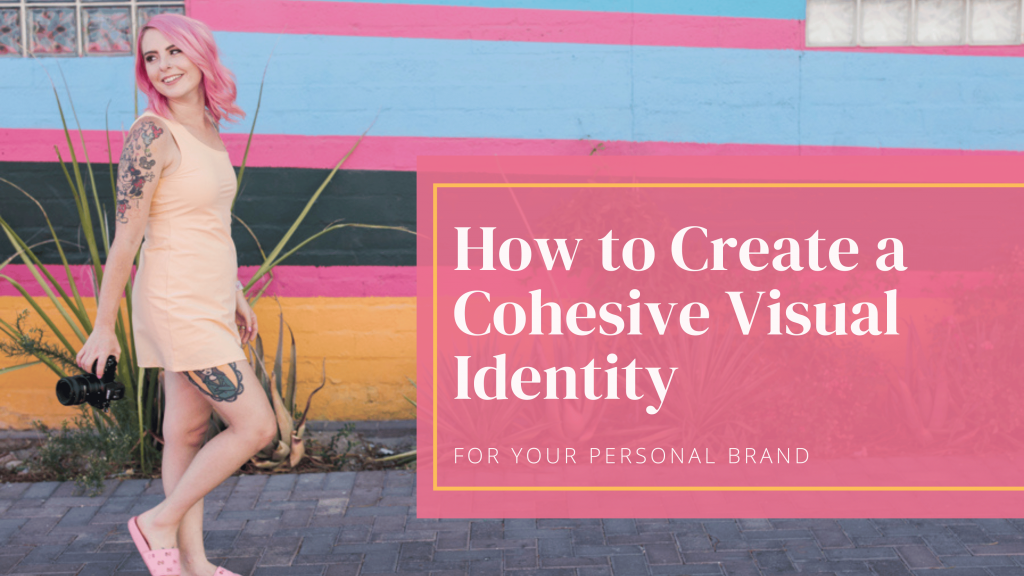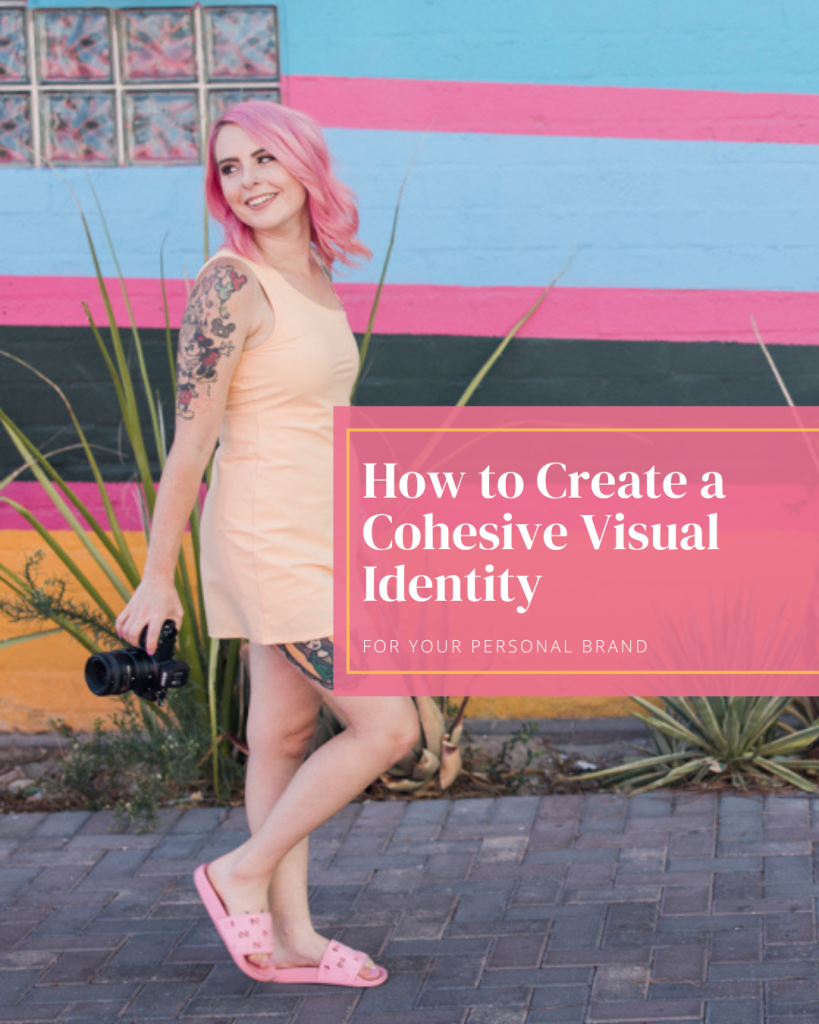
Creating a cohesive visual identity for your personal brand or small business is more crucial that ever! The online space is growing more and more each day. As the online space grows it’s necessary to stand out and really make a lasting impression o your audience.
A cohesive visual brand is essential for presenting a consistent and professional image. In addition, it helps to communicate your brand message effectively and build trust with your audience. – By creating a cohesive visual brand, you can stand out from the competition, showcase your expertise, and build a solidified personal reputation.
Let’s look at the steps you can take to create a cohesive visual brand for yourself and elevate your personal brand image.
Identify Your Personal Values, Desires, and Strengths
Before creating your visual brand, you must clearly understand who you are and what you stand for. Consider your personal values, desires, and unique strengths, and use this information to guide your brand decisions.
Ask yourself what makes you unique, what you want to achieve, and what image you want to present to the world.
Understand Your Target Audience: Understanding your target audience is vital to creating a visual brand that resonates with them. Consider who you want to reach, what they are looking for, and what kind of image they respond to.
Research your target audience, their interests, and the kinds of visual elements they are drawn to. Use this information to inform your visual brand decisions.
Develop a Unique Brand Message: A brand message is a statement that communicates your brand and what you stand for. It should be simple, straightforward, and memorable.
Develop a unique brand message that captures the essence of who you are and what you offer. Use this message to guide your visual brand decisions and ensure that everything you create aligns with it.
Determine the Tone and Personality You Want to Convey: The tone and personality you want to convey through your visual elements should be consistent with your brand message.
Consider the words and phrases that describe your brand and use them to guide the tone and personality you want to convey through your visual elements. Your visual elements should reflect your brand’s values and the image you want to present to the world.
Gather Inspiration
A mood board represents the aesthetic you want to achieve for your visual brand. Start by gathering inspiration from other brands, websites, and visual elements that align with your brand message.
Save images, colors, typography, and other design elements that resonate with you, and use them to inspire your brand’s aesthetic visually.
Identify Color Schemes, Typography, and Design Elements: As you gather inspiration, pay close attention to the color schemes, typography, and design elements used.
Consider the emotions that different colors evoke and choose a color scheme that aligns with your brand message. The same goes for typography, which should be easy to read and convey the tone you want to set.
Create a Visual Representation of Your Brand’s Aesthetic: Once you have gathered your inspiration, use it to create a mood board that showcases the aesthetic you want to achieve for your visual brand.
Your mood board should visually represent your brand’s personality and the design elements you want to incorporate. Use it as a reference as you continue to develop your visual brand.
Define Your Visual Elements
Put your personal work and your emotional inspiration to work and develop the visual elements that represent your brand. Here are the steps you want to take when defining your visual elements.
Establish Your Color Scheme and Typography: Your color scheme and typography are two of your brand’s most important visual elements. They set the tone for your brand and help to create a consistent look and feel.
Choose colors that align with your brand message and evoke the emotions you want to convey. Your typography should be legible, easy to read, and consistent across all materials.
Decide on Imagery and Iconography: Imagery and iconography are essential visual elements that can help to communicate your brand message and personality.
Choose images that align with your brand message and reflect the personality you want to convey. Consider using icons and symbols to create a consistent visual language for your brand.
Creating Visual Patterns and Design Elements: Visual patterns and design elements, such as patterns, borders, and backgrounds, can help to create a unique and consistent look for your brand.
Use these elements to create a unique visual identity for your brand and helps to communicate your brand message.
Developing Your Logo
Your logo is the centerpiece of your visual brand and should be simple, memorable, and scalable. A simple logo design is easier to recognize and remember, while scalability means that your logo should look good in any size and format.
When designing your logo, focus on creating a simple, memorable, and scalable design.
Hiring a Professional Designer or Using Online Tools to Create Your Logo:
You have two main options for creating your logo: hiring a professional designer or using online tools.
Hiring a professional designer can be a great option if you have a specific vision for your logo and want to ensure it is executed flawlessly. However, it can be expensive and time-consuming.
Online tools, on the other hand, can be a quick and cost-effective solution for creating a logo. Many of these tools have pre-made templates and design elements that you can use to create a logo that is unique to your brand.
Incorporating Your Visual Elements into Your Logo Design:
Your logo should incorporate your visual elements and reflect your brand’s aesthetic and message.
Use the color scheme, typography, and other design elements you defined earlier to create a logo consistent with your brand. Make sure your logo is simple, memorable, and scalable and effectively communicates your brand message and personality.
Keep it consistent
Consistency is Key when creating a cohesive visual brand. Ensure your visual elements are consistent across all materials, including your website, social media profiles, business cards, and marketing materials.
Consistent use of color, typography, imagery and other visual elements will help to create a solid and recognizable brand identity.
Updating Your Visual Elements Regularly:Your visual brand should evolve and change over time as your brand evolves and grows.
Regularly review and update your visual elements to ensure they align with your brand message and personality. Make changes gradually and thoughtfully to avoid confusion and ensure that your brand remains recognizable and consistent.
Stay true to yourself:As you create and evolve your visual brand, staying true to your brand identity is essential. Don’t be tempted to follow design trends or make changes for the sake of change. Make sure that any changes align with your brand message and personality.
Stay focused on creating a consistent and recognizable visual brand that reflects your unique personality and message.
By following these steps, you’ll be able to create a visual brand that is aligned with your message and personality and helps you to stand out from the crowd.
Creating a cohesive visual brand takes time and effort, but it’s worth it in the end. A solid visual brand helps you to communicate your message effectively, build recognition, and establish trust with your audience.
Start small and build your visual brand gradually over time, focusing on consistency and alignment with your brand message and personality.
Remember, consistency is key, and by following these steps, you’ll be well on your way to creating a visual brand that reflects your unique personality & message and calls in the perfect people to work with you.

